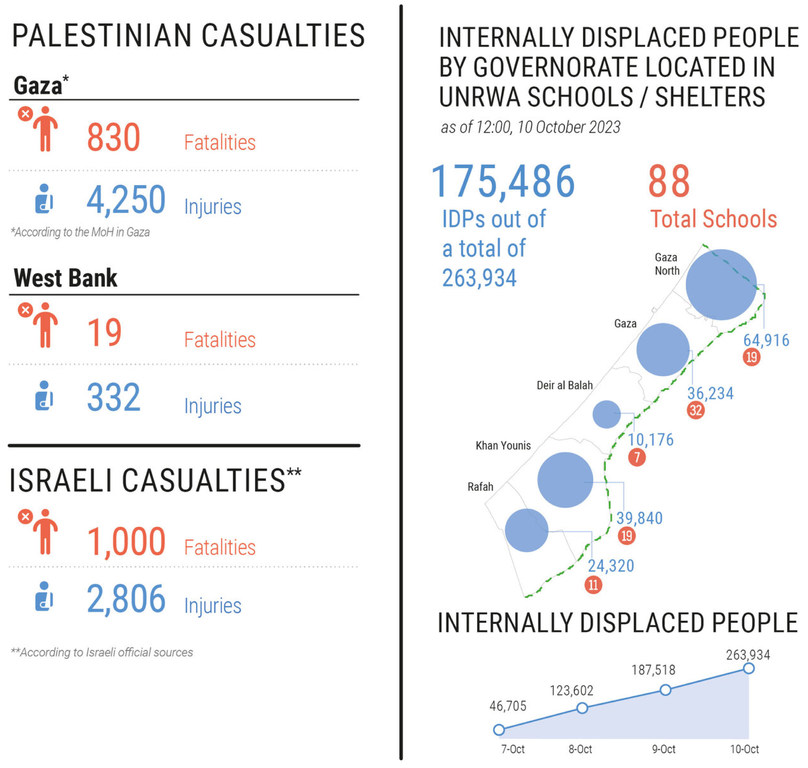The United Nations has been working in the Middle East region around the clock to de-escalate the Israeli-Palestinian crisis by engaging key actors and providing emergency assistance to civilians on the ground.
As the conflict intensified amid escalating violence, a complete blockade of food, water, and vital services was put in place by Israel as reports emerged of Israeli ground operations in Gaza, which is home to more than two million people.
While UN offices in Gaza sustained “significant damage” from nearby airstrikes on Monday night, agencies were striving to help the affected population there and elsewhere, including the West Bank, home to 871,000 registered refugees.
The UN relief agency for Palestine refugees, UNWRA, currently has 13,000 national and international staff, most of them refugees themselves, in Gaza and nearly 4,000 in the West Bank.
In addition, hundreds of employees continued working for other UN agencies.

© UNRWA
A building housing the UNRWA headquarters in Gaza City sustains significant damage following nearby airstrikes.
Along the restive Israel-Lebanon border, the UN peacekeeping mission there, UNIFIL, is operating with 9,400 ground troops, 900 civilian staff, and 850 naval personnel on its Maritime Task Force.
Here is a snapshot of how the UN is helping on the ground:

© UNRWA/Mohammed Hinnawi
Families gather at UNRWA’s New Gaza Boys’ School, seeking shelter from heavy airstrikes.
1. Protection
Heavy airstrikes since 7 October had displaced nearly 190,000 people in Gaza, so the UN relief agency for Palestine refugees, UNRWA, is sheltering 137,500 men, women, and children in 83 of its 288 schools, according to the agency’s latest situation report. As of Tuesday, 18 UNRWA facilities sustained collateral and direct damage from airstrikes, with injuries and deaths reported.

UNIFIL/Pasqual Gorriz
UN peacekeepers patrol the Blue Line in El Odeisse, south Lebanon.
2. De-escalation
Top UN officials, including the Office of the UN Special Coordinator for the Middle East Peace Process (UNSCO), Tor Wennesland, were engaging with parties to the conflict and key stakeholders, including the United States, Qatar, and the European Union, to de-escalate the conflict.

© UNOCHA
The Gaza Strip prior to the current escalation.
The UN peacekeeping mission in Lebanon, UNIFIL, continued to monitor the unfolding “volatile” security situation along the Israel-Lebanon border, issuing guidance for civilians and updates via social media.
“We have fully engaged our liaison and coordination mechanisms at all levels, to help avoid misunderstandings between Lebanon and Israel that could lead to an escalation of the conflict,” UNIFIL said. “This is our main focus at the moment, and we are working 24/7 to accomplish it.”
3. Emergency services
Israel’s announced blockade of food, water, fuel, and electricity in Gaza on Monday came as UN agencies warned of food scarcity and a looming crisis. Mobile toilets and showers were being deployed to UNRWA shelters, as needed.
As of 10 October, Palestinians in Gaza only had electricity for three to four hours per day, hindering the ability of health facilities to function and treat those injured, the UN humanitarian coordination agency, OCHA, said.
4. Food
The World Food Programme (WFP) and UNRWA were coordinating the distribution of bread to displaced people in the shelters in Gaza.
“Nearly half a million people, or 112,000 families, have not been able to get their food rations this week since UNRWA food distribution centres are closed,” UNRWA said.
As of Tuesday, WFP started distributing fresh bread, canned food, and ready-to-eat foods to around 100,000 people at UNRWA shelters, with plans to reach more than 800,000 affected people in Gaza and the West Bank.

© WFP/Ali Jadallah
WFP food distribution at an UNRWA school in Gaza that is a designated shelter in times of emergency.
5. Health
Emergency healthcare services were being offered through the toll-free hotline continued across Gaza. The UN’s country-based pooled funds (CBPF) and its partners released life-saving trauma and emergency drugs and medical supplies to enable the health system in Gaza to respond to rising needs.

© UNOCHA
Palestinian casualties and internally displaced people in Gaza.
A total of 125 health staff are working in rotating shifts at UNRWA health centres, with 15 out of 22 clinics providing primary healthcare services from 9 am to 12 pm to patients with urgent referred appointments received through a free-toll hotline.
Relief and social services helplines were operational as of Tuesday, and psychosocial support and psychological first aid were being provided remotely.
The UN Children’s Fund (UNICEF) had psychosocial support experts ready to provide assistance to those who needed it in Gaza and in the West Bank.
“The community is appealing to UNRWA to open the closed health centres due to the high demand for services,” the agency said.
6. Humanitarian corridors
Access for humanitarian staff and supplies into Gaza was cut this week and the intensity of the hostilities was limiting the ability of staff to deliver aid, according to Lynn Hastings, the UN Humanitarian Coordinator for the occupied Palestinian territory.
Meanwhile, the World Health Organization (WHO), other UN agencies, and partners continued to work towards establishing a corridor to reach people with critical supplies in Gaza.